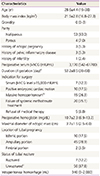1. Walker JJ. Ectopic pregnancy. Clin Obstet Gynecol. 2007; 50:89–99.
2. Al-Sunaidi M, Tulandi T. Surgical treatment of ectopic pregnancy. Semin Reprod Med. 2007; 25:117–122.
3. Farquhar CM. Ectopic pregnancy. Lancet. 2005; 366:583–591.
4. Fylstra DL, Soper DE. Ectopic pregnancy. In : Gilstrap LC, Cunningham FG, Vandorsten JP, editors. Operative obstetrics. 2nd ed. Philadelphia (PA): McGraw-Hill;2002. p. 355–378.
5. Hajenius PJ, Mol F, Mol BW, Bossuyt PM, Ankum WM, van der Veen F. Interventions for tubal ectopic pregnancy. Cochrane Database Syst Rev. 2007; (1):CD000324.
6. Yao M, Tulandi T. Current status of surgical and nonsurgical management of ectopic pregnancy. Fertil Steril. 1997; 67:421–433.
7. Mol F, Mol BW, Ankum WM, van der Veen F, Hajenius PJ. Current evidence on surgery, systemic methotrexate and expectant management in the treatment of tubal ectopic pregnancy: a systematic review and meta-analysis. Hum Reprod Update. 2008; 14:309–319.
8. Alkatout I, Honemeyer U, Strauss A, Tinelli A, Malvasi A, Jonat W, et al. Clinical diagnosis and treatment of ectopic pregnancy. Obstet Gynecol Surv. 2013; 68:571–581.
9. DeCherney AH, Boyers SP. Isthmic ectopic pregnancy: segmental resection as the treatment of choice. Fertil Steril. 1985; 44:307–312.
10. van Mello NM, Mol F, Opmeer BC, de Bekker-Grob EW, Essink-Bot ML, Ankum WM, et al. Salpingotomy or salpingectomy in tubal ectopic pregnancy: what do women prefer? Reprod Biomed Online. 2010; 21:687–693.
11. Elmoghazy DA, Nour-El-Dine NM. Prevention of persistent ectopic pregnancy with single dose methotrexate after surgical conservation of the tube. Int J Gynecol Obstet. 2000; 70:B57.
12. Gracia CR, Brown HA, Barnhart KT. Prophylactic methotrexate after linear salpingostomy: a decision analysis. Fertil Steril. 2001; 76:1191–1195.
13. Graczykowski JW, Mishell DR Jr. Methotrexate prophylaxis for persistent ectopic pregnancy after conservative treatment by salpingostomy. Obstet Gynecol. 1997; 89:118–122.
14. Hajenius PJ, Mol BW, Ankum WM, van der Veen F, Bossuyt PM, Lammes FB. Clearance curves of serum human chorionic gonadotrophin for the diagnosis of persistent trophoblast. Hum Reprod. 1995; 10:683–687.
15. Song T, Kim MK, Kim ML, Jung YW, Yoon BS, Seong SJ. Laparoscopic salpingotomy using the floseal hemostatic sealant in patients with tubal pregnancy. J Laparoendosc Adv Surg Tech A. 2014; 24:651–655.
16. Seifer DB, Diamond MP, DeCherney AH. Persistent ectopic pregnancy. Obstet Gynecol Clin North Am. 1991; 18:153–159.
17. Hajenius PJ, Engelsbel S, Mol BW, Van der Veen F, Ankum WM, Bossuyt PM, et al. Randomised trial of systemic methotrexate versus laparoscopic salpingostomy in tubal pregnancy. Lancet. 1997; 350:774–779.
18. Fujishita A, Masuzaki H, Khan KN, Kitajima M, Hiraki K, Ishimaru T. Laparoscopic salpingotomy for tubal pregnancy: comparison of linear salpingotomy with and without suturing. Hum Reprod. 2004; 19:1195–1200.






 PDF
PDF ePub
ePub Citation
Citation Print
Print



 XML Download
XML Download